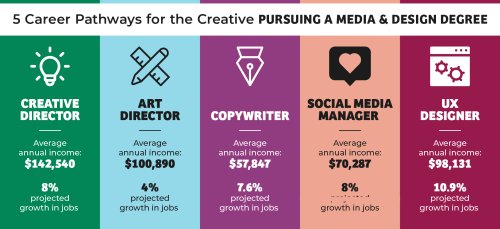
Five Career Pathways for the Creative Pursuing a Media + Design Degree
If you ask the most esteemed designers what the #1 skill needed for the modern-day field is, you'll probably get a good number of responses emphasizing creativity.
After all, marketing any product or service requires a mindset that's "outside of the box" to truly captivate a target audience and make a profitable sale along the way.
Luckily for creatives, the field of Media + Design is a career oasis for anyone with a forward-thinking mind, opening opportunity upon opportunity to lead a lucrative, fulfilling role.
With help from our flexible, in-demand Media + Design program at the Tulane School of Professional Advancement (Tulane SoPA), you can unlock your creative calling in the industry, no matter if it's crafting content or designing software.
How a Media + Design Degree Inspires Creative Innovation
In the 21st-century sea of pop-up banners and billboards, a creative mindset makes the difference between an ad that stands out and one that falls short of meeting the mark.
Fortunately, the Media + Design program gives aspiring creatives a leg up in the fast-paced industry with innovative skills that help to cut through the clutter.
Often led by industry veterans, these programs immerse students in the techniques of brainstorming, storyboarding, and creating visually compelling content through hands-on experience. Whether it's by completing coursework-related projects or working with real-world businesses, Media + Design students benefit from the chance to build their creative portfolio and gain career-ready skills at the same time.
Media + Design degrees are incredibly versatile, just like the role of creativity across industries. As such, these programs can land you a career that's thriving, exciting, and right up your alley — whatever that may look like to you.
Five Creative Career Pathways for Media + Design Students
For creatives pursuing Media + Design programs, honing the itch for innovation might start in the classroom, but it carries its weight well into the field.

1. Creative Director
The head of the creative department in an advertising agency or a company’s in-house marketing department, a creative director is responsible for designing and implementing advertisements and other marketing initiatives.
These influential professionals use their creativity to craft a cohesive image of a company’s brand and manifest it through digital and print ads. They lead and guide their creative staff in producing advertising and marketing products that maintain a consistent visual and thematic style across projects and campaigns.
Acting as the final sign-off on all things creative, creative directors also review and approve advertising and marketing concepts before they can be presented to clients.
Creative directors earn high salaries, with an average annual income of about $142,000, and can expect to see a job growth of 8 percent over the coming years.
2. Art Director
While art directors are often confused with creative directors, their difference lies in their scope of responsibilities.
Unlike a creative director, who is in charge of the entire creative tasks in an agency or company, an art director solely focuses on the execution of the visual aspects of an advertising or marketing campaign.
As the head of the artistic team, the art director determines which visual elements to apply to a specific project and communicates the vision to their fellow staff. This creative professional is also responsible for creating budgets and timelines, determining how to present the creative director’s concepts, and approving related tasks.
To develop visual concepts for ad campaigns, art directors use their creativity to figure out the creative vision of a company and reveal it by creating artwork and graphics. In addition to creating storyboards and sketches, art directors come up with various details about visual ads, including fonts, pictures, colors, and more.
On average, art directors bag a salary of just under $101,000 annually, with a projected 4 percent growth rate in jobs from 2021-2031.
3. Copywriter
Copywriting involves creating written content and is, without a doubt, a significant tenet of media and design.
A copywriter produces engaging texts for various channels, including print catalogs and digital ads. As part of the job, they often research keywords, write content, and proof the work for accuracy, facts, and quality. Additionally, copywriters will edit and modify content to meet their clients' needs and expectations.
Copywriting is a broad field, with smaller scopes including:
- Print copywriting
- Digital copywriting
- Social media copywriting, and
- SEO copywriting
Regardless of the type of copywriting one specializes in, copywriters need a knack for creativity. An innovative outlook is necessary for brainstorming client ideas and writing compelling and persuasive content that engages readers and aligns with particular brand expectations, such as tone and messaging.
According to Indeed, the average annual income for copywriters in the U.S. is about $57,850, with CareerExplorer projecting the job market to grow by 7.6 percent between 2016 and 2026.
4. Social Media Manager
Given that over 4 billion people use social media globally, it’s no surprise that working as a social media manager is a common route for graduates of the Media + Design program.
The role of a social media manager is all about envisioning, establishing, and maintaining a client or company's social media presence, whether it's on Facebook, LinkedIn, or anything in between. Aside from creating multimedia content to engage existing customers and attract new prospects, they're also focused on positively increasing brand exposure.
As a social media manager, creativity is critical to creating unique written or visual content that captures a brand’s tone and resonates with the target audience.
But creativity is only half the battle.
Successful social media managers also stay up to date by researching current industry trends and customer preferences to design and execute fresh, engaging content.
As a social media manager, you can expect to earn about $70,300 annually, with the job market poised to increase by 8 percent, based on research by Zippia.
5. Interactive UX/UI Designer

User experience/user interface design, or interactive UX/UI design, focuses on creating useable and practical digital products to guarantee a seamless customer experience.
An interactive UX/UI designer conducts and develops personas via user research and data to help comprehend users’ behaviors, experiences, goals, and needs. These creative pros perform usability testing to ensure resources are as user-friendly as possible and work with developers and designers to craft intuitive software.
Wearing a few different hats, interactive UX/UI designers also help promote brand loyalty and customer satisfaction by ensuring the end users have the most positive experience.
Since interactive UX/UI design involves making products fun and easy to use, designers use their creativity to identify users’ needs and develop better solutions to improve their experience.
Interactive UX/UI designers receive an average yearly salary of about $98,000. The interactive UX/UI design design job market is also promising, with a job growth rate of 10.9 percent, above the average for all occupations.
Kickstart Your Creative Career With a Media + Design Degree From Tulane SoPA
Creativity is among the most in-demand skills employers seek in today's competitive job market.
For those in the media and design industry, being creative and innovative isn't just a perk on your resume — it's a requirement to create the marketing elements that sell and sell well.
Whether you want to work in a full-service or specialized marketing agency, our Media + Design program at Tulane SoPA can equip you with the necessary skills and forward-thinking mind to find your place in the creative world.
Want to learn more? Request more info to see what you can make possible in your career with our Media + Design program.
Explore Our Most Recent Media + Design News & Blog Posts
Request Information
By submitting this form, you agree to receive information about the Tulane School of Professional Advancement’s programs via email, phone and/or text. You may opt out at any time.




